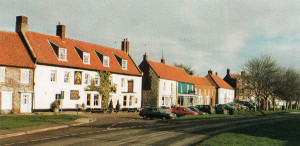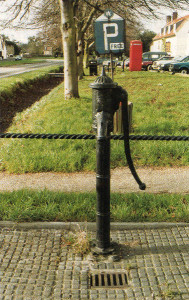
“Rag’n’Booane, Rag’n’Booane”.
This sound could be heard regularly in the street where I lived 55 years ago. We heard the cries long before we could see the rag and bone man with his horse and cart piled high with old clothes, shoes and domestic ware. He would give a few pennies, even a silver sixpence, in exchange for a bundle of clothes or footwear. I never saw anyone give him any bones.
He lived in Front Street, Burnham Market, where our rented house had once been a butcher’s shop. The room in front still had the wooden counter in place and a stone-flagged floor. We used it for our playroom in the summer, but in the winter it was far too cold. My brother and I used to sit cross-legged on the counter and watch the happenings in the street through the shop window.
Every day, except Sunday, the milkman came along with his handcart hung about with shiny brass measures, graduating in size from a gill to a quart. Housewives took out their enamel jugs and a few coppers. We never bought any as we were lucky enough to have four pints a milk a day free straight from the Jersey cows on the farm where my father was secretary We all drank it into our mid-teens, and in spite of today’s health warnings about a full fat milk, I put my good skin and strong nails down to it, also the teeth I still have in my sixties.

Men with wooden yokes and pails passed on their way to and from the village pump on the green. The pump is still there, preserved as a reminder of days past. We had our own pump in the back yard, but no drain. Through a series of ramshackle sheds and outhouses was the privy, near which was the only patch of earth, which acted as a soakaway for any waste water. The night cart man came once a week to empty the privy. He just poured it all into a huge oval shaped bucket which he then carried out and emptied into his cart. He often used to stop and have a chat with my mother, still with the full bucket in one hand. I don’t know where the waste matter was deposited.
Next door but one to us towards the green was Zenas Roys, the china shop. Zenas was renowned, not only for his name, but for the fact that he was one of 19 children, 17 of whom survived to adulthood.
As children, we were sometimes invited to Sunday lunch after the morning service at the Gospel Hall. While the rest of us sat around the large scrubbed table to eat our meal, Zenas had his own small table. He had a short, sharp knife and a large white plate. Upon finishing his main course, he cleaned his plate with a piece of bread and had his pudding on the same plate. He used only the knife and bread to eat his dinner, allowing himself the use of a spoon for dessert. He also had a huge, white saucer-less cup full of tea.
An unmarried sister lived with them until she died, well into her eighties. When I married, she presented me with a rectangular dish with six smaller plates patterned in blue and yellow. Included in the box was a silver server. It was a mince pie set, and I have never seen another since. It had obviously been in the china shop since its opening.
Opposite, in a house with a box window, was Warne’s, the jewellers. I used to love standing on tiptoe to view the rings and brooches pinned on to black velvet. The only time I ever visited its dark interior and tiny counter was when my aunt broke her ‘pearls’ while on a visit. I was sent to buy a new length of waxed thread so they could be re-threaded.
Further down the street, opposite each other, were two more shops. The one on our side was Warne & Massey, the village stationer. Even during the war it was full of things loved by children – dolls and toys, picture books and pencils. After the war, they also stocked a limited supply of fireworks at the beginning of November, and crepe paper, tinsel and crackers in December.
Opposite was the wool shop, staffed by two more of Zenas’ female relations, both wearing buns and spectacles. Every space was jammed with skeins of wool which, during the war, comprised mostly greys, navies, and khakis. There were embroidery silks, tapestry wools, crochet hooks, needles of all descriptions – anything to do with knitting or sewing. There were rolls of pink and white squared paper for pattern-making, pattern books and knitting patterns. Buttons were stored in sundry tins, along with shirt studs, bones for collars and rubber buttons for Liberty bodices. I remember saving up my farthings to buy a shiny silver thimble.
Between Warne & Massey’s and our house was the cobbler’s. His shop was dark, tiny and cramped, and smelled of leather. There were piles of boots and shoes everywhere, yet he always seemed to know whose shoes were where. Two visits were needed before the repair was completed; the second acted
as a reminder and always did the trick. Shoelaces and polish were also available there.
Further down were the premises of Billy Muse, the barber. I had the job of taking my eldest brother to have his hair cut. I chatted away non-stop and got only monosyllables or grunts in reply. My brother never uttered a word. We often had to wait quite a long time as grown men took precedence over small boys. The cut was of the pudding basin variety, and lasted a month. I think it cost a shilling. I remember a huge, spotted mirror and a wooden bench to sit on while waiting. Shaving was fascinating. First the razor strop, then a brush and lots of lather. Brylcreem was applied after each cut, and the hairs were brushed from the back of the neck, but as there was no towel or cape over the shoulders, my brother suffered form an itchy back for the first day.
Trett’s, one of the four village bakers, were at the far end of the street, opposite the Lord Nelson Inn (Horatio Nelson was born in the neighbouring village of Burnham Thorpe, and his father was rector for Burnham Market). Run by Mrs Trett, it was possible to buy small bread buns in the shape of a loaf for one penny. Alongside was an archway where wooden trays of bread were loaded into the delivery vans.
Opposite Trett’s on the other side was a
pair of semi-detached houses, for the use of the headmaster and headmistress of the boys’ and girls’ and infants’ schools respectively.
Between Billy Muse’s and the teachers’ residences was an alleyway leading to North Street, known locally as Back Street, on which were the entrances for both schools. Alongside was Burnham Sutton Church where Lord Nelson’s father regularly took services. I was lifted over the wall by the headmistress to practise for the egg and spoon race by running around the paths in the churchyard.
And what of Front Street today? There are no shops at all, but the church remains. The school is in use as Council Offices and the Lord Nelson Inn is still open for business.
Our house has been renovated, including the removal of the shop counter and demolition of the outbuildings and has been given a name – ‘High House’.
Although it is sad that all the shops have gone, it is pleasing to see that strict control has been exercised over renovations and alterations in order to preserve the character of the original buildings, and it is still perfectly possible to identify all the structures I remember so well from my childhood.
Lois Rowe
Portugal








